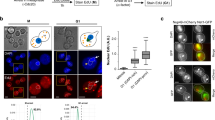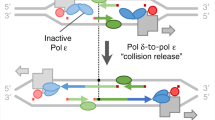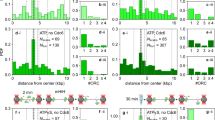Abstract
THE nuclear DNA of the yeast Saccharomyces cerevisiae has been the subject of a detailed electron microscopic examination1,2. These studies have revealed long, continuous molecules of lengths up to 355 µm, which correspond to the molecular weights of nuclear DNA estimated from sedimentation analysis in sucrose gradients. Several replication structures (bubbles) were observed along single molecules2,3, as found in other eukaryotes4,5. The most useful observations were made on selected replicating DNA3 and on DNA of mutants that were arrested just after the initiation of DNA synthesis6. We have started to study the structure of DNA molecules during meiosis because of its direct relevance to the process of recombination. Models to explain recombination (for review see ref. 7) are based mostly on genetic data from meiotic analysis, among which yeast tetrads occupy an important position. The various models have molecular implications which could best be tested by the direct examination and quantification of the interactions among DNA molecules, and between DNA and proteins, during meiosis.
This is a preview of subscription content, access via your institution
Access options
Subscribe to this journal
Receive 51 print issues and online access
$199.00 per year
only $3.90 per issue
Buy this article
- Purchase on Springer Link
- Instant access to full article PDF
Prices may be subject to local taxes which are calculated during checkout
Similar content being viewed by others
References
Petes, T. D., Byers, B., and Fangman, W. L., Proc. natn. Acad. Sci. U.S.A., 70, 3072–3076 (1973).
Petes, T. D., Newlon, C. S., Byers, B., and Fangman, W. L., Cold Spring Harb. Symp. quant. Biol., 38, 9–16 (1973).
Newlon, C. S., Petes, T. D., Hereford, L. M., and Fangman, W. L., Nature, 247, 32–35 (1974).
Huberman, J. A., and Riggs, A. D., J. molec. Biol., 32, 327–341 (1968).
Callan, H. G., Proc. R. Soc., B 181, 19–41 (1972).
Petes, T. D., and Newlon, C. S., Nature, 251, 637–639 (1974).
Hotchkiss, R. D., A. Rev. Microbiol., 28, 445–468 (1974).
Hotta, Y., and Stern, H., J. molec. Biol., 55, 337–355 (1971).
Laird, C. D., Chromosoma, 32, 378–406 (1971).
Hurst, D. D., Fogel, S., and Mortimer, R. K., Proc. natn. Acad. Sci. U.S.A., 69, 101–105 (1972).
Simchen, G., Genetics, 76, 745–753 (1974).
Simchen, G., Piñon, R., and Salts, Y., Expl Cell Res., 75, 207–218 (1972).
Piñon, R., Salts, Y., and Simchen, G., Expl Cell Res., 83, 231–238 (1974).
Kleinschmidt, A. K., Lang, D., Jacherts, D., and Zahn, R. K., Biochim. biophys. Acta, 61, 857–846 (1962).
Clark-Walker, G. D., Eur. J. Biochem., 32, 263–267 (1973).
Fogel, S., and Mortimer, R. K., Proc. natn. Acad.Sci. U.S.A., 62, 96–103 (1969).
Hartwell, L. H., Bact. Rev., 38, 164–198 (1974).
Author information
Authors and Affiliations
Rights and permissions
About this article
Cite this article
SIMCHEN, G., FRIEDMANN, A. Structure of DNA molecules in yeast meiosis. Nature 257, 64–66 (1975). https://doi.org/10.1038/257064a0
Received:
Accepted:
Published:
Issue Date:
DOI: https://doi.org/10.1038/257064a0
This article is cited by
-
Biochemical analysis of genetic recombination in eukaryotes
Heredity (1977)
-
Mechanism of conjugation and recombination in bacteria XVI
Molecular and General Genetics MGG (1977)
Comments
By submitting a comment you agree to abide by our Terms and Community Guidelines. If you find something abusive or that does not comply with our terms or guidelines please flag it as inappropriate.



